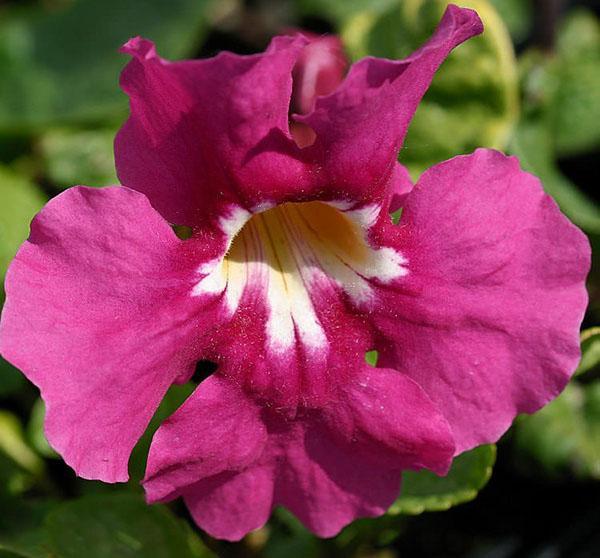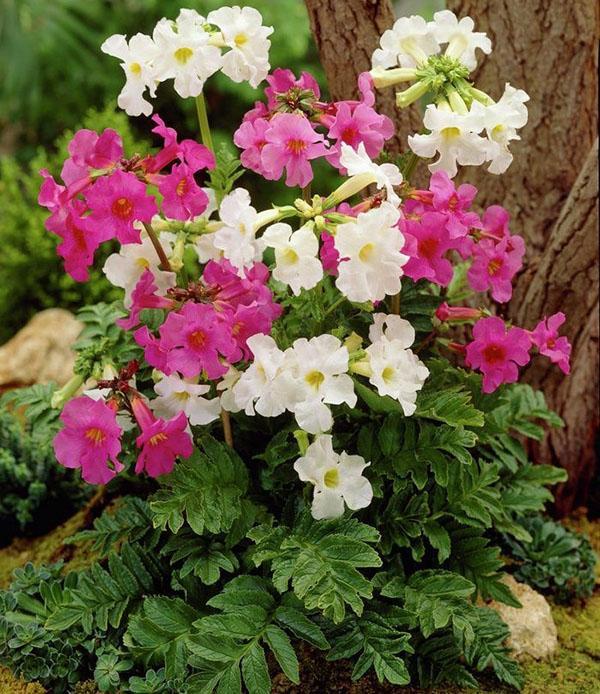Modest garden beauty - incarvillea
 Long before the appearance of man on earth, it was decorated with various flowers. Among this lush splendor of plants, of course, grew a modest beauty - Incarvillea. In accordance with popular beliefs, flowers are the symbolic hair of the Earth, which decorates it in an original way. Depending on the weather conditions, they replace each other to inspire and delight a person. Spring flowers replace summer ones, and autumn and frost-resistant winter specimens appear behind them. So for a whole year we live surrounded by silent gentle creatures.
Long before the appearance of man on earth, it was decorated with various flowers. Among this lush splendor of plants, of course, grew a modest beauty - Incarvillea. In accordance with popular beliefs, flowers are the symbolic hair of the Earth, which decorates it in an original way. Depending on the weather conditions, they replace each other to inspire and delight a person. Spring flowers replace summer ones, and autumn and frost-resistant winter specimens appear behind them. So for a whole year we live surrounded by silent gentle creatures.
Most people pay attention to garden flowers. Among the many options, I would like to highlight one modest beauty.
Incarville got its name in honor of the famous French missionary Pierre de Incarville. He was an ardent fan of green plants, so he looked for the most bizarre options. When the botanist was in China, the pearl of his collection was an unusual perennial flower. Pierre carefully studied this plant, observing it in natural conditions. What is he, this modest garden handsome man?
Wonderful Flower Outer Robe

The plant can grow from 20 centimeters to 150 centimeters. Its shoots are smooth, decorated with a delicate edging, simple or branched. Original paniculate inflorescences are formed on their tops. Each flower of Incarvillea consists of 5 tubular petals, the diameter of which reaches 6 cm.The color is:
- white;
- deep pink;
- red;
- yellow.
The shape of the bud is similar to gloxinia, because of this, some color lovers call it Incarvillea. The first bloom falls in June. It often lasts a month and a half. It all depends on the variety. The second wave of blooming is in August, although not so lush. A careful study of the photo of Incarvillea helps to clearly imagine this natural masterpiece.
 During this period, pods appear from the inflorescences. When they ripen and crack, large, gray seeds fall to the ground. Their germination capacity lasts up to 4 years. The sheet plate has a corrugated surface. It reaches 30 cm in length. The color is dark green.
During this period, pods appear from the inflorescences. When they ripen and crack, large, gray seeds fall to the ground. Their germination capacity lasts up to 4 years. The sheet plate has a corrugated surface. It reaches 30 cm in length. The color is dark green.
The rhizome of the garden beauty is tuberous, slightly branched. It has an elongated cylindrical shape, outwardly resembles dahlia plots. These features should be taken into account when growing and caring for an Incarvillea.
The plant is used to decorate rocky areas of the garden, in flower beds and in rock gardens. For its bright outfit, the flower is sometimes called the front garden "orchid". It looks original in bouquets, although it can be stored in a cut for only 2 days.
Secrets of growing an oriental beauty
To grow Incarvillea in your garden, you should consider the following points:
- The plant loves moderate sunlight. Considering this fact, cultivation of Incarvillea in semi-shaded areas promotes long flowering.
- The rhizome of the garden "orchid" does not tolerate high humidity. In order to avoid decay of the root system, before planting the plant, drainage is laid out on the bottom of the hole. For this you can use crushed stone, expanded clay or crushed brick.
- Fertile soil. Incarvillea prefers a loose soil with good moisture permeability.
- Resistant to prolonged droughts. Thanks to this, the flower does not need frequent watering.
- Regular feeding. In order for the plant to bloom as long as possible, it needs feeding. The best option is to process the soil near the bushes once every 14 days fertilizers.
Incarvillea can thrive wonderfully without transplant for 5 years.
Often, in severe winters with little snow, plants can freeze slightly. To protect the flowers from this, the tubers are carefully dug out. You can store them in the basement in a small amount of soil or in the refrigerator, abundantly covered with sawdust.
 The principle of planting Incarvillea in open ground and caring for it is quite simple. In early spring, the preserved tubers are planted in pots of humus. In this case, you should not close the root collar. By the time the plant is planted in the open ground, new leaves will appear, due to which the Incarvillea will bloom in mid-June.
The principle of planting Incarvillea in open ground and caring for it is quite simple. In early spring, the preserved tubers are planted in pots of humus. In this case, you should not close the root collar. By the time the plant is planted in the open ground, new leaves will appear, due to which the Incarvillea will bloom in mid-June.
 Caring for a garden beauty, you should correctly to water... Although the plant tolerates dry periods well, it does not need to make it a desert. It is enough to thoroughly moisten the soil under the flower once a week.
Caring for a garden beauty, you should correctly to water... Although the plant tolerates dry periods well, it does not need to make it a desert. It is enough to thoroughly moisten the soil under the flower once a week.
Watering should be soaking, not superficial. It is desirable that moisture reaches the root tubers of the plant. So the incarvillea will be able to thrive painlessly in the summer cottage.
Acquaintance with popular varieties
The exotic flower that came to us from China is of different types. Gardeners have about 14 options. The most popular ones are:
- Delaway;
- Mayra;
- Olga;
- Chinese;
- Dense.
A short description of each of them will help you get to know them.
Incarvillea Delaway
 Having considered the photos of Delaway's Incarvillea, it is not difficult to fall in love with this delicate, humble flower. The plant was first discovered in southwestern China. The flower grows up to 120 cm in height. The leaves are collected in the form of a rosette near the rhizome. Their length is 30 cm.
Having considered the photos of Delaway's Incarvillea, it is not difficult to fall in love with this delicate, humble flower. The plant was first discovered in southwestern China. The flower grows up to 120 cm in height. The leaves are collected in the form of a rosette near the rhizome. Their length is 30 cm.
Incarvillea buds are colored pink. The middle of the cup is yellow. Diameter - about 6 cm. Flowers are collected in several pieces in pretty carpal inflorescences. The buds bloom in June and bloom until mid-summer.
Planting and leaving Incarvillea Delaway includes the following operations:
- Sowing seeds. The plant can be sown in early spring in pots, and when the ground warms up - in open ground. The first shoots appear within a week. There will be no bloom in the first year of Incarvillea.
- Division of the rhizome. This type of flower planting is practiced in early spring or late autumn. The rhizome dug out of the ground is cut into pieces, and then it is added dropwise with a small amount of soil.
- Cuttings. In the middle of summer, cuttings of the Delaway Incarvillea are cut along with a small part of the shoot. They are placed in a container with water until the roots appear. The finished seedlings are planted in the ground.
 A rooted plant requires moderate watering. It is advisable to cover the flower for the winter. Decorative form of Dilaweya with white color of buds - Incarvillea Snowtop.
A rooted plant requires moderate watering. It is advisable to cover the flower for the winter. Decorative form of Dilaweya with white color of buds - Incarvillea Snowtop.
Mayra variety
 The flower grows up to 30 cm. The leaves are slightly dissected. The outer part of the buds is colored deep pink, the inner part is yellow with small white spots. It blooms in early summer. Not afraid of cold weather.
The flower grows up to 30 cm. The leaves are slightly dissected. The outer part of the buds is colored deep pink, the inner part is yellow with small white spots. It blooms in early summer. Not afraid of cold weather.
Incarvillea Olga
 This variety grows up to half a meter. Shoots are strong, slightly branched from above. Leaves are dissected, feathery. A white incarvillea requires special attention, Its buds are collected in a panicle and located at the top of the shoots. Flowering begins in mid-summer and lasts a month and a half.
This variety grows up to half a meter. Shoots are strong, slightly branched from above. Leaves are dissected, feathery. A white incarvillea requires special attention, Its buds are collected in a panicle and located at the top of the shoots. Flowering begins in mid-summer and lasts a month and a half.
Incarvillea Chinese
 Some types of Incarvillea Chinese have creamy yellow or pinkish inflorescences and feathery leaves. The flower grows up to 30 cm. It blooms 2.5 months after planting.
Some types of Incarvillea Chinese have creamy yellow or pinkish inflorescences and feathery leaves. The flower grows up to 30 cm. It blooms 2.5 months after planting.
Incarvillea Dense
 A dwarf variety that grows up to 30 cm in height. Shoots of a smooth character, slightly drooping. Leaves are oval, with feathery roots. Blooms in June in large white or pink buds with a yellow center. The variety is frost-resistant, therefore it hibernates without shelter.
A dwarf variety that grows up to 30 cm in height. Shoots of a smooth character, slightly drooping. Leaves are oval, with feathery roots. Blooms in June in large white or pink buds with a yellow center. The variety is frost-resistant, therefore it hibernates without shelter.
To choose the best option, you should take into account the local climate, the type of soil and the flowering time of the plant.
When you get to know different plants closely, it's easy to imagine your garden in all its glory. Incarvillea - a modest garden beauty can be the perfect decoration for a summer cottage.
Check out my new monograph "The genus Incarvillea and the mysterious Niedzwedzkia" (St. Petersburg, Super-Publishing House, 2019).